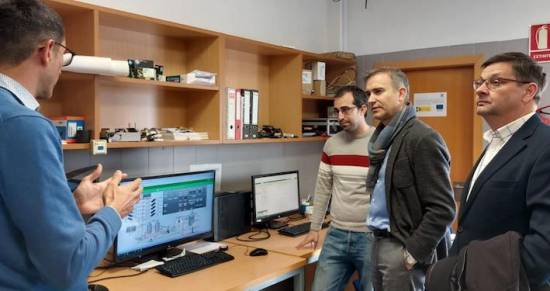
The territorial delegate of Employment, Enterprise and Autonomous Work, Amós García Hueso, has positively valued the growth of technological employment in the province of Almería by 78.3% in the last decade and has predicted that occupations linked to technology will continue to increase in the province in the coming years due to the boom in the digitalisation of many economic sectors such as agriculture, considering sustainability and the blue economy to be very important. He also highlights the inclusion of content related to training and digital improvements in the training specialities in order to be more competitive.
Amós García recalled the incentives to promote the digitalisation of companies and self-employed workers offered by the Regional Ministry of Employment, Enterprise and Self-Employment, such as the lines of aid that support the modernisation and digitalisation of trade and crafts and their associations, those aimed at facilitating digital transformation and supporting the innovation of self-employed workers and social economy companies or the territorial projects for rebalancing and equity aimed at entrepreneurship and micro-enterprises and self-employed workers and social economy companies, which promote digitalisation and the green economy.
In addition, the delegate stressed that the growth rate between 2013 and 2023 of technological employment in Almeria, 78.3%, is higher than the variation recorded in the national set, where it grew by 48%, and in the Andalusian community, where it increased by 68%. This growth has increased the weight of technological employment in the province of Almeria from 0.5% in 2013 to the current 2.1%.

In 2013, there were 3,687 members in technological jobs in the province of Almeria and in 2023, this number had risen by 2,886 people, 78.3%, to 6,573 members. In contrast, non-technological employment in the last decade has grown at a much slower rate in the province, by 33.7%. The greatest increase is in programming, consultancy and computer services, with 1,055 more workers in the last ten years, followed by R&D, with 847 more workers.
At a greater distance is the chemical industry, which gained 399 members in the last ten years; the manufacture of machinery and equipment with 162 more members; the manufacture of transport machinery with 137 more members; telecommunications with an increase of 113 members; cinematographic and video activities, television programmes and sound recording, with 85 more members; information services, which added 43 new members; the manufacture of pharmaceutical products with 27 more members; the manufacture of computer products, with 22 more members; and the manufacture of electrical material and equipment, with 7 new members.
The data referred to by the regional delegate are those contained in a report by the Cotec Foundation on the evolution of technological employment throughout Spain in the last decade and the current situation of occupations in this field. The report includes an interactive tool, a map of technological employment that analyses data on Social Security affiliation in the 13 most technological branches of activity in the economy in the industrial and services sectors.
IT and R&D, main activities
The report also indicates that in 2024 there are 6,590 people affiliated in the province of Almería within the technological occupations indicated, and details their weight in the whole. The most relevant occupation, with 28.4% of those affiliated (1,871 people), is programming and consultancy and activities related to information technology, followed by research and development, which accounts for 21.9% of those affiliated (1,442 people).
In third place is the chemical industry, which accounts for 13.2% of technology workers in the province (871), in fourth place is the manufacture of machinery and equipment with 8.7% of technology workers (575) and in fifth place is telecommunications, with 545 workers, 8.3%.
At a greater distance are film, video, television and sound recording activities (270 members, 4.1%), manufacture of pharmaceutical products (269 members, 4.1%), information services (with 3.7% and 247 members), manufacture of other transport equipment (228 workers, 3.4%), television programming and broadcasting activities (111 employees, 1.7%), manufacture of electrical materials and equipment (62 employees, 0.9% of the total), manufacture of motor vehicles and trailers (60 employees, 0.9%) and manufacture of computer products (0.6% of the total, 39 employees).
